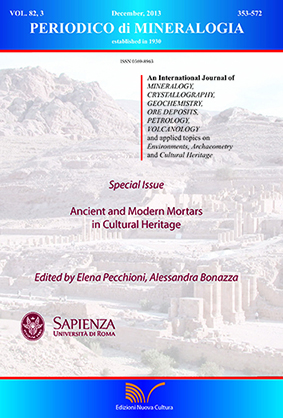Characterization of hydraulic mortars from archaeological complexes in Petra
DOI:
https://doi.org/10.2451/2013PM0027Keywords:
Mortar, Reaction rims, Hydraulicity, Raw materialsAbstract
In the sixth century BC Petra was conquered by the Nabataeans, who built an elaborated water system and turned a desert city into an artificial oasis and a prosperous centre controlling the main commercial routes of the region (100 BC - 100 AD). In 2007, it was added to UNESCO’s prestigious list of World Heritage Sites, as one of the seven wonders of the world. The aim of this research is to characterize samples of mortars lining cisterns, reservoirs and pipelines collected from the archeological site of Petra, focusing in general on the identification of the possible raw materials employed and in particular on those components conferring hydraulicity. Specifically the specimens were sampled from different structures of the Great Temple (cistern and pipelines) and of the Garden and Pool Complex (cisterns and reservoir floor). A petro-mineralogical characterization was carried out by polarized light microscopy (PLM) observations to identify the texture and to highlight the hydraulic reaction areas, which underwent subsequently to a more detailed morphological and elemental analysis by scanning electron microscopy (SEM-EDX). X-Ray Diffraction analyses (XRD) were also performed to complete the petrographic characterization, while thermal analyses (DTA-TGA) were carried out to classify the level of hydraulicity of each sample. The data obtained allowed us to achieve for the first time a mineralogical and petrographic characterization of the lining hydraulic mortars present in the two archaeological complexes under study and to provide preliminary hypotheses on the provenance of the raw materials employed for their production.


